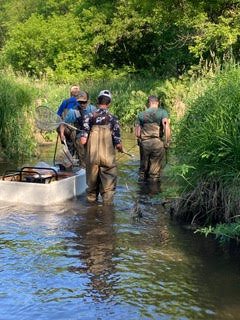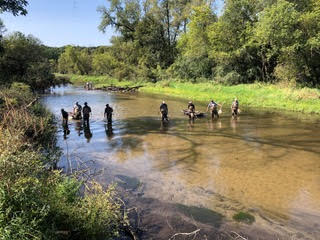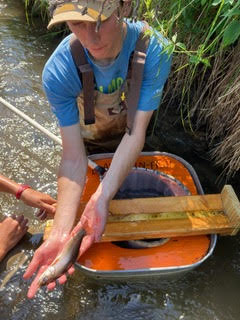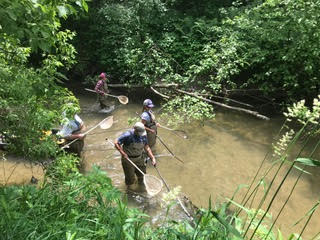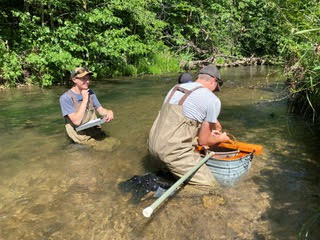I recently had the pleasure of joining Fisheries Biologist Kasey Yallaly and her crew on a stream survey of
a marvelous little Brook Trout stream in Dunn County. Kasey’s crew is made up of three college- and
high-school-aged young men—Dustin, Sam, and Parker—who will be assisting her throughout the
summer.
Starting out with temperatures in the low nineties and finishing with the mercury hovering around the
century mark, survey conditions were clearly less than optimal. Luckily, the stream temperatures were
satisfyingly below the air temperature, making conditions a bit more tolerable. Mind you, I was just an
observer and perfectly happy bringing up the rear as I watched Kasey and crew swipe their magic wands
back and forth beneath the stream’s surface, and under tree roots and logjams, to bring the stunned trout
to the surface for capture and measuring.
Being a casual observer allowed me to see just how much work goes into surveys of this type. There is
a lot of bull work involved, the hardest of which is towing a small boat loaded with a gasoline generator
and a sizable washtub fill with water that serves as a temporary aquarium for the soon-to-be-measured
trout.
Once all the equipment is readied, a typical survey starts out with one of the crew members setting the
amount of current that will be generated by the electrical control box that sends a current into the water
through the hand-held wands. The electricity briefly attracts the fish and temporarily stuns them so they
can be easily captured. After additional safety checks are made and the wands are activated, the crew
members hook themselves up to the boat in a fashion that reminded me of a team of horses pulling a hay
wagon. Each member is armed with a net and a wand as they progress upstream in a well-
choreographed display of quick reflexes and hand-eye coordination. The fish dizzyingly come to the
surface and are quickly scooped up and transferred to the holding tank. It was quite amazing to observe
the number of trout that could be netted from a deeper pool or deep pockets along the shore, often with a
tree root thrown in for good measure.
At a predetermined stopping point, the net results (pun intended) are examined for disease and
measured for length, then quickly released. I particularly enjoyed this part of the survey—not only seeing
these beautifully colored trout up close, but watching Kasey’s quick-handed aides pull each specimen out
of the tank to try to get the wiggly creature to hold still long enough to be measured.
Fish surveys of this type are essential for building successful management programs. Each survey
provides biologists with insight into how fish populations are responding to current management plans
and environmental changes. Collected data enhance knowledge of water quality, riparian habitat, and
stream degradation, allowing biologists to craft unique management techniques for each system and to
achieve sustainable fisheries now and into the future. Climate change will necessitate continued vigilance
and well-conceived planning in order to sustain our quality fisheries. From my perspective, our streams
are in very good hands, and we are fortunate to have an abundance of well-managed streams from which
to choose when we decide to wet a line.
